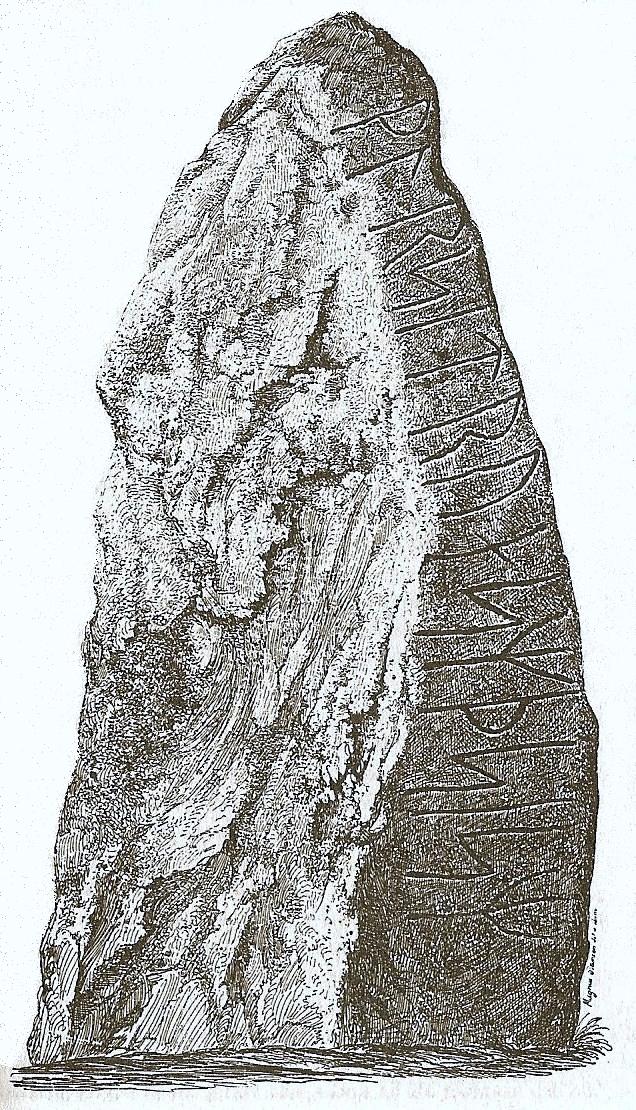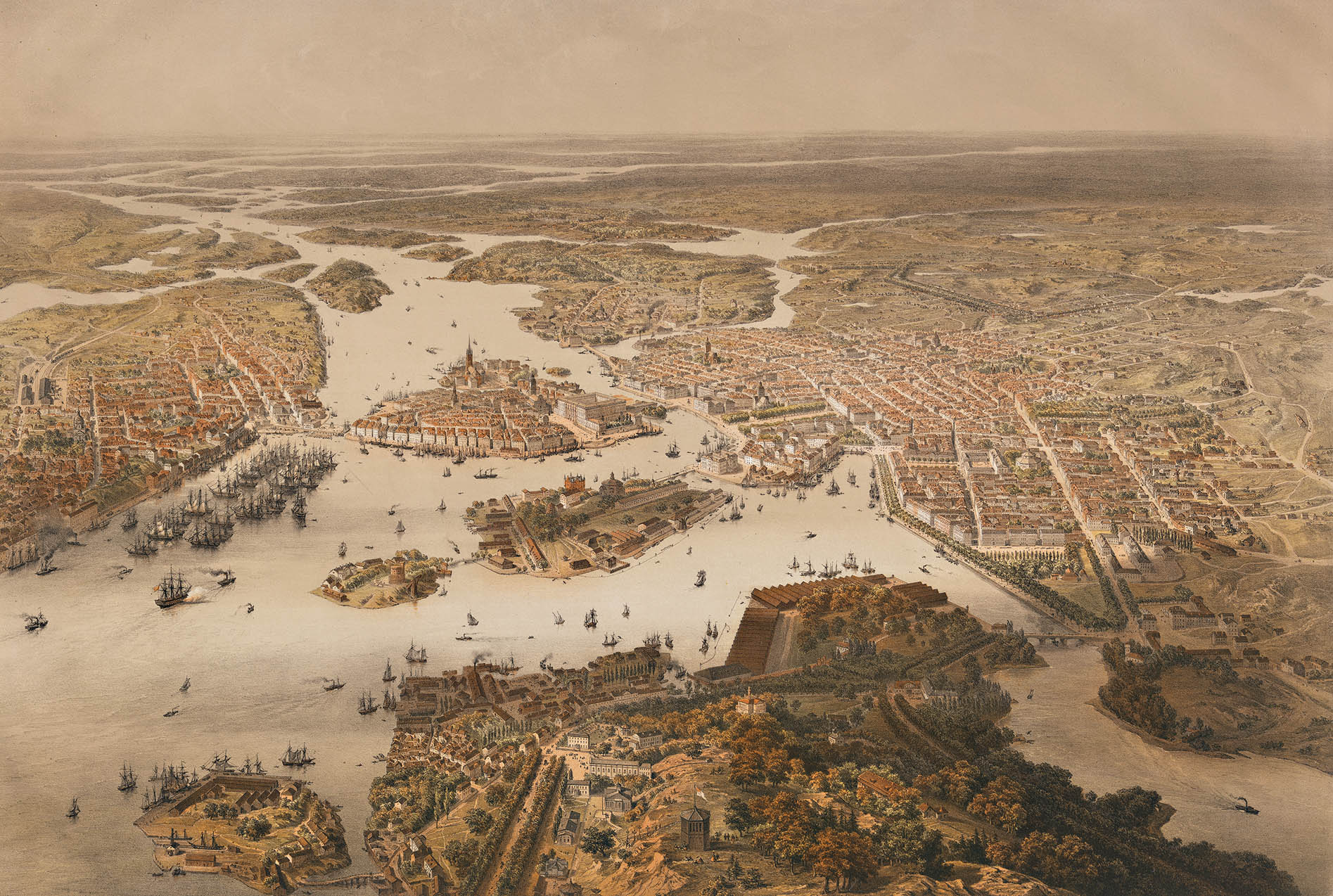|
Istaby Runestone
The Istaby Runestone, listed in the Rundata catalog as DR 359, is a runestone with an inscription in Proto-Norse which was raised in Istaby, Blekinge, Sweden, during the Vendel era (c. 550-790). Inscription Transliteration into Latin characters :AP :AQ :B Projektet Samnordisk runtextdatabas - entry for DR 359. Transcription into Proto-Norse :AP :AQ :BEnglish translation :AP In memory of Hariwulfar. Haþuwulfar, Heruwulfar's son, :AQ Haþuwulf(a)r, Heruwulfar's son, in memory of Hariwulfar :B wrote these runes.Interpretation The Istaby, |
Hærulf Runestone
The Hærulf Runestone is a Viking Age runestone located north of Hovslund's station in Southern Jutland, Denmark. Description The Hærulf Runestone dates from the 10th century and is classified as being carved in runestone style RAK. This is the classification for inscriptions with runic bands that have straight ends without any attached serpent or beast heads. The stone was originally located at Øster Løgum Project Samnordisk Runtextdatabas Svensk - Rundata entry for DR 15. near the north-south Jutland highway. It is notable not only for its short inscription, which is the name Hærulf, but for having been taken to Berlin as war booty in 1864. It was not until 1952 that the stone was returned to Denmark near to its original location. Although the inscription only has a single word, a single dot, which is normally a punctuation mark used as a word divider, has been placed before and after the runes hairulfʀ for the name Hærulf. This name is a shortened form of the Pro ... [...More Info...] [...Related Items...] OR: [Wikipedia] [Google] [Baidu] |
Proto-Norse Language
Proto-Norse (also called Ancient Nordic, Ancient Scandinavian, Ancient Norse, Primitive Norse, Proto-Nordic, Proto-Scandinavian and Proto-North Germanic) was an Indo-European language spoken in Scandinavia that is thought to have evolved as a northern dialect of Proto-Germanic in the first centuries CE. It is the earliest stage of a characteristically North Germanic language, and the language attested in the oldest Scandinavian Elder Futhark inscriptions, spoken from around the 2nd to the 8th centuries CE (corresponding to the late Roman Iron Age and the Germanic Iron Age). It evolved into the dialects of Old Norse at the beginning of the Viking Age around 800 CE, which later themselves evolved into the modern North Germanic languages ( Faroese, Icelandic, the three Continental Scandinavian languages, and their dialects). Phonology Proto-Norse phonology probably did not differ substantially from that of Proto-Germanic. Although the phonetic realisation of several ... [...More Info...] [...Related Items...] OR: [Wikipedia] [Google] [Baidu] |
8th-century Inscriptions
The 8th century is the period from 701 ( DCCI) through 800 ( DCCC) in accordance with the Julian Calendar. The coast of North Africa and the Iberian Peninsula quickly came under Islamic Arab domination. The westward expansion of the Umayyad Empire was famously halted at the siege of Constantinople by the Byzantine Empire and the Battle of Tours by the Franks. The tide of Arab conquest came to an end in the middle of the 8th century.Roberts, J., '' History of the World'', Penguin, 1994. In Europe, late in the century, the Vikings, seafaring peoples from Scandinavia, begin raiding the coasts of Europe and the Mediterranean, and go on to found several important kingdoms. In Asia, the Pala Empire is founded in Bengal. The Tang dynasty reaches its pinnacle under Chinese Emperor Xuanzong. The Nara period begins in Japan. Events * Estimated century in which the poem Beowulf is composed. * Classical Maya civilization begins to decline. * The Kombumerri burial grounds are fou ... [...More Info...] [...Related Items...] OR: [Wikipedia] [Google] [Baidu] |
7th-century Inscriptions
The 7th century is the period from 601 (DCI) through 700 ( DCC) in accordance with the Julian calendar in the Common Era. The spread of Islam and the Muslim conquests began with the unification of Arabia by Muhammad starting in 622. After Muhammad's death in 632, Islam expanded beyond the Arabian Peninsula under the Rashidun Caliphate (632–661) and the Umayyad Caliphate (661–750). The Muslim conquest of Persia in the 7th century led to the downfall of the Sasanian Empire. Also conquered during the 7th century were Syria, Palestine, Armenia, Egypt, and North Africa. The Byzantine Empire suffered setbacks during the rapid expansion of the Caliphate, a mass incursion of Slavs in the Balkans which reduced its territorial limits. The decisive victory at the Siege of Constantinople in the 670s led the empire to retain Asia Minor which assured the existence of the empire. In the Iberian Peninsula, the 7th century was known as the ''Siglo de Concilios'' (century of councils) r ... [...More Info...] [...Related Items...] OR: [Wikipedia] [Google] [Baidu] |
6th-century Inscriptions
The 6th century is the period from 501 through 600 in line with the Julian calendar. In the West, the century marks the end of Classical Antiquity and the beginning of the Middle Ages. The collapse of the Western Roman Empire late in the previous century left Europe fractured into many small Germanic kingdoms competing fiercely for land and wealth. From the upheaval the Franks rose to prominence and carved out a sizeable domain covering much of modern France and Germany. Meanwhile, the surviving Eastern Roman Empire began to expand under Emperor Justinian, who recaptured North Africa from the Vandals and attempted fully to recover Italy as well, in the hope of reinstating Roman control over the lands once ruled by the Western Roman Empire The Western Roman Empire comprised the western provinces of the Roman Empire at any time during which they were administered by a separate independent Imperial court; in particular, this term is used in historiography to describe the period f ... [...More Info...] [...Related Items...] OR: [Wikipedia] [Google] [Baidu] |
Swedish National Heritage Board
The Swedish National Heritage Board ( sv, Riksantikvarieämbetet; RAÄ) is a Swedish government agency responsible for World Heritage Sites and other national heritage monuments and historical environments. It is governed by the Ministry of Culture. The goals of the agency are to encourage the preservation and protection of historic environments and to promote the respect for and knowledge of historic environments. In order to do this, it tries to ensure that Swedish heritage is accessible to all citizens, to spread information about that heritage, and to "empower heritage as a force in the evolution of a democratic, sustainable society". History 17th and 18th century The National Heritage Board was founded in 1630. On the 20May that year, Johannes Bureus who was a prominent rune researcher and King Gustavus Adolphus' private teacher, was appointed the first ''riksantikvarien'' ("National Antiquarian"). Bureus' teachings had made the king interested in ancient monuments ... [...More Info...] [...Related Items...] OR: [Wikipedia] [Google] [Baidu] |
Erik Moltke
Erik Moltke (4 April 1901 – 19 October 1984) was a Danish runologist, writer, and editor. Through his leadership, the Runologist Section of the National Museum of Denmark became a world centre for the scientific study of runology.Moltke, Erik (1985). ''Runes and Their Origin: Denmark and Elsewhere'', rear cover page. Copenhagen: Nationalmuseets Forlag. In 1942, Moltke and Lis Jacobsen published the standard edition of Danish inscriptions. Moltke also held the position of Chief Editor of the National Museum of Denmark's series of volumes on Denmark's churches until his wife Elna Møller Elna Møller Moltke (12 December 1913 – 22 May 1994) was a Danish architect and author. Biography Moltke was born at Tange Skovgård in Højbjerg parish, Denmark. She was the daughter of Niels Rasmussen Møller (1880-1950) and Johanne Due ... assumed the position in 1970. Publications ''Note: This section may be incomplete.'' *Moltke, Erik (1985). ''Runes and Their Origin: Denmark ... [...More Info...] [...Related Items...] OR: [Wikipedia] [Google] [Baidu] |
List Of Runestones
There are about 3,000 runestones in Scandinavia (out of a total of about 6,000 runic inscriptions). p. 38. The runestones are unevenly distributed in Scandinavia: The majority is found in Sweden, estimated at between 1,700 and 2,500 (depending on definition). Denmark has 250 runestones, and Norway has 50. There are also runestones in other areas reached by the Viking expansion, especially in the British Isles ( Manx runestones, Page, Raymond I. (1995). Runes and Runic Inscriptions: Collected Essays on Anglo-Saxon and Viking Runes'. Parsons, D. (ed.) Woodbridge: Boydell Press, 207–244 England runestones, Scotland and Ireland) and other islands of the North Atlantic (Faroes, Greenland, but not in Iceland), and scattered examples elsewhere (the Berezan' Runestone in Eastern Europe, Pritsak, O. (1987). ''The Origin of Rus'.'' Cambridge, Mass.: Distributed by Harvard University Press for the Harvard Ukrainian Research Institute. Sawyer, Birgit. (2000). The Viking-Age Rune-Stones ... [...More Info...] [...Related Items...] OR: [Wikipedia] [Google] [Baidu] |
Stockholm
Stockholm () is the Capital city, capital and List of urban areas in Sweden by population, most populous city of Sweden as well as the List of urban areas in the Nordic countries, largest urban area in the Nordic countries. Approximately 1 million people live in the Stockholm Municipality, municipality, with 1.6 million in the Stockholm urban area, urban area, and 2.4 million in the Metropolitan Stockholm, metropolitan area. The city stretches across fourteen islands where Mälaren, Lake Mälaren flows into the Baltic Sea. Outside the city to the east, and along the coast, is the island chain of the Stockholm archipelago. The area has been settled since the Stone Age, in the 6th millennium BC, and was founded as a city in 1252 by Swedish statesman Birger Jarl. The city serves as the county seat of Stockholm County. Stockholm is the cultural, media, political, and economic centre of Sweden. The Stockholm region alone accounts for over a third of the country's Gross d ... [...More Info...] [...Related Items...] OR: [Wikipedia] [Google] [Baidu] |
Swedish Museum Of National Antiquities
The Swedish History Museum ( sv, Historiska museet or Statens historiska museum) is a museum located in Stockholm, Sweden, that covers Swedish archaeology and cultural history from the Mesolithic period to present day. Founded in 1866, it operates as a government agency and is tasked with preserving Swedish historical items as well as making knowledge about history available to the public. The origin of the museum is the collections of art and historical objects gathered by Swedish monarchs since the 16th century. It has a number of permanent exhibitions and annually hosts special exhibitions tied to current events. Function The History Museum is part of a central museum agency called the ''Statens historiska museer'' (SHM) ("National Historical Museums"). Other museums under the aegis of this agency are The Royal Armouries, The Economy Museum, Skokloster Castle, The Hallwyl Museum the Tumba Papermill Museum. History The foundation for what was to become the Swedish Hi ... [...More Info...] [...Related Items...] OR: [Wikipedia] [Google] [Baidu] |





